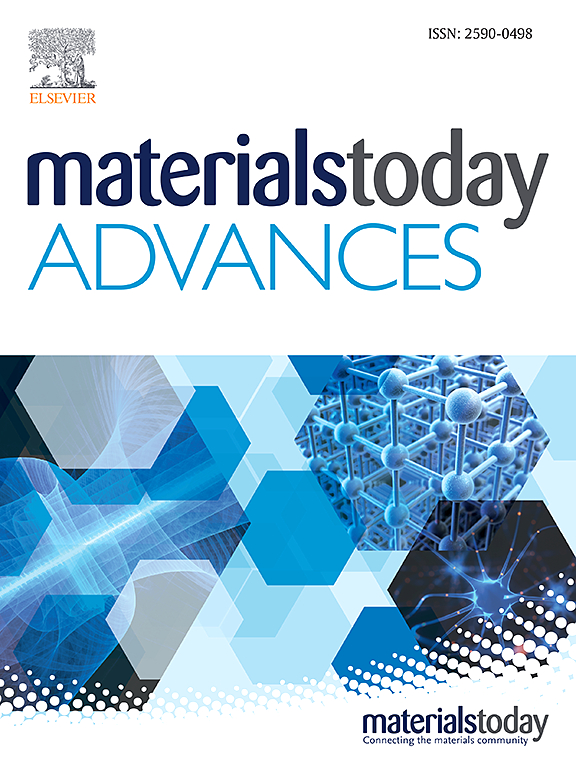Structural, optical and electrical properties in multilayer SnS2(1-x)Se2(x) compounds for energy, thermoelectric and photocatalytic application
IF 8
2区 材料科学
Q1 MATERIALS SCIENCE, MULTIDISCIPLINARY
引用次数: 0
Abstract
Band gap engineering is crucial in the development of two-dimensional layered materials in nanoelectronics, optoelectronics, and photonics fields. In this study, we present characteristics of layered SnSSe (0 ≤ x ≤ 1) ternary alloys grown via chemical vapor transport (CVT) with tunable compositions. Polarized micro-Raman spectroscopy shows the existence of intralayer E and A modes in all the compositions. The A mode demonstrates a pronounced resonant intensity, whilst the E mode is significantly weaker. In the ternary compositions, two groups of E and A modes undergo shift, reflecting lattice and bond transitions from S-rich to Se-rich compositions. Micro-thermoreflectance and optical transmission spectroscopy reveal tunable optical properties consistent with the alloy-composition change. All samples exhibit a single band-edge transition peak, shifting from 1.3 eV (for pure SnSe) to 2.3 eV (for pure SnS), indicating high-quality alloy nanosheets of SnSSe. The optical and electrical applications, such as photodegradation, photoconductivity, and thermoelectric performance are also explored. The alteration in selenium composition within SnSSe is observed to significantly influence potential applications of the materials. The materials with a predominant selenium composition exhibit superior electrical and thermoelectric properties, whereas those with a sulfur-dominant composition manifest enhanced optical characteristics. The engineered 2D structures presents promising opportunities for investigating their fundamental physical properties and also exploring their wide-range applications in electronic and optoelectronic devices, as well as in the field of energy and photocatalytic application.

用于能源、热电和光催化应用的多层 SnS2(1-x)Se2(x)化合物的结构、光学和电学特性
带隙工程对于二维层状材料在纳米电子学、光电子学和光子学领域的发展至关重要。在本研究中,我们介绍了通过化学气相传输(CVT)生长的具有可调成分的层状 SnSSe(0 ≤ x ≤ 1)三元合金的特性。偏振微拉曼光谱显示,在所有成分中都存在层内 E 和 A 模式。A 模式具有明显的共振频率,而 E 模式则明显较弱。在三元成分中,两组 E 和 A 模式发生了转变,反映了从富 S 成分到富 Se 成分的晶格和键的转变。显微热反射光谱和透射光谱显示了与合金成分变化相一致的可调光学特性。所有样品都显示出单个带边转变峰,从 1.3 eV(纯 SnSe)转变到 2.3 eV(纯 SnS),表明了高质量的 SnSSe 合金纳米片。此外,还探讨了光降解、光导和热电性能等光学和电学应用。据观察,SnSSe 中硒成分的变化会对材料的潜在应用产生重大影响。硒成分占主导地位的材料具有优异的电学和热电性能,而硫成分占主导地位的材料则具有更强的光学特性。这种工程二维结构为研究其基本物理性质以及探索其在电子和光电设备、能源和光催化应用领域的广泛应用提供了大好机会。
本文章由计算机程序翻译,如有差异,请以英文原文为准。
求助全文
约1分钟内获得全文
求助全文
来源期刊

Materials Today Advances
MATERIALS SCIENCE, MULTIDISCIPLINARY-
CiteScore
14.30
自引率
2.00%
发文量
116
审稿时长
32 days
期刊介绍:
Materials Today Advances is a multi-disciplinary, open access journal that aims to connect different communities within materials science. It covers all aspects of materials science and related disciplines, including fundamental and applied research. The focus is on studies with broad impact that can cross traditional subject boundaries. The journal welcomes the submissions of articles at the forefront of materials science, advancing the field. It is part of the Materials Today family and offers authors rigorous peer review, rapid decisions, and high visibility.
 求助内容:
求助内容: 应助结果提醒方式:
应助结果提醒方式:


